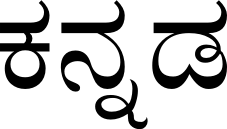Language/Kannada/Grammar/Present-Tense
| ◀️ Everyday Actions — Previous Lesson | Next Lesson — Past Tense ▶️ |
As a Kannada language teacher, I have had the pleasure of teaching Kannada for 20 years. Today, we will learn how to conjugate verbs in the present tense in Kannada. This is an important grammar structure that you will use in many situations to describe what is happening currently.
Consider exploring these related pages after completing this lesson: How to Use Have & Past Tense.
Regular Verbs[edit | edit source]
Most verbs in Kannada follow a particular pattern when conjugated in the present tense. To conjugate a regular verb, remove the '-ವ-' (-va-) at the end of the infinitive form of the verb and add the appropriate tense endings.
For example, let's conjugate the verb 'ಬರು' (baru) which means to come.
| Kannada | Pronunciation | English |
|---|---|---|
| ನಾನು ಬರುತ್ತೇನೆ | nānu baruttēne | I am coming |
| ನೀವು ಬರುತ್ತೀರಿ | nīvu baruttīri | You are coming |
| ಅವನು/ಅವಳು/ಅದು ಬರುತ್ತದೆ | avanu/avalu/adu baruttade | He/She/It is coming |
| ನಾವು ಬರುತ್ತೇವೆ | nāvu baruttēve | We are coming |
| ನೀವು ಬರುತ್ತೀರಿ | nīvu baruttīri | You all are coming |
| ಅವರು ಬರುತ್ತಾರೆ | avaru baruttāre | They are coming |
Note that the suffix '-ಯು' (-yu) is added to the verb root in some cases for more clarity in pronunciation.
Irregular Verbs[edit | edit source]
There are some common verbs in Kannada that do not follow the regular verb pattern when conjugated in the present tense. Here are a few examples:
| Kannada | Pronunciation | English |
|---|---|---|
| ಇದೆ | ide | It is there |
| ಆಗುತ್ತದೆ | āguttade | It is happening |
| ತಿನ್ನುತ್ತೇನೆ | tinnuttēne | I am eating |
| ಕೊಯ್ಯುತ್ತಾರೆ | koyuttāre | They are buying |
These verbs must be memorized separately, as they do not follow the regular conjugation patterns.
Negation[edit | edit source]
To negate a sentence in Kannada, 'ಇಲ್ಲ' (illa) or 'ಕೆಲವು ವೇಳೆ' (kelavu vēḷe) can be used at the end of the sentence. Here are examples of negating both regular and irregular verbs in the present tense:
Regular verb example: ನಾನು ಹೋಗುವುದಿಲ್ಲ (nānu hōguvudilla) means "I am not going"
Irregular verb example: ಅದು ಇಲ್ಲ (adu illa) means "It is not there"
Conclusion[edit | edit source]
Mastering verb conjugation in Kannada is an essential step in reaching proficiency in the language. Remember to practice regularly and don't be afraid to make mistakes!
Finished this lesson? Check out these related lessons: Gender & Consonants.
Videos[edit | edit source]
What is Simple Present Tense | ವಾಕ್ಯ ರಚನೆ (In Kannada ...[edit | edit source]
Other Lessons[edit | edit source]
- Prepositions
- Past Tense
- Give your Opinion
- Future Tense
- Adjectives
- Pronouns
- Vowels
- Conjuncts
- Conditional Mood
Sources[edit | edit source]
| ◀️ Everyday Actions — Previous Lesson | Next Lesson — Past Tense ▶️ |

